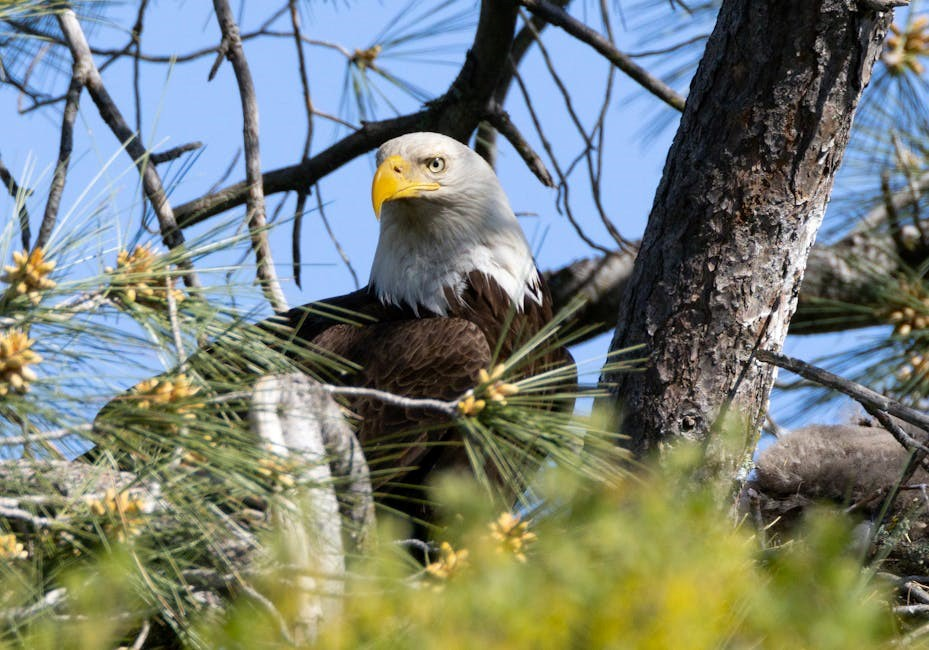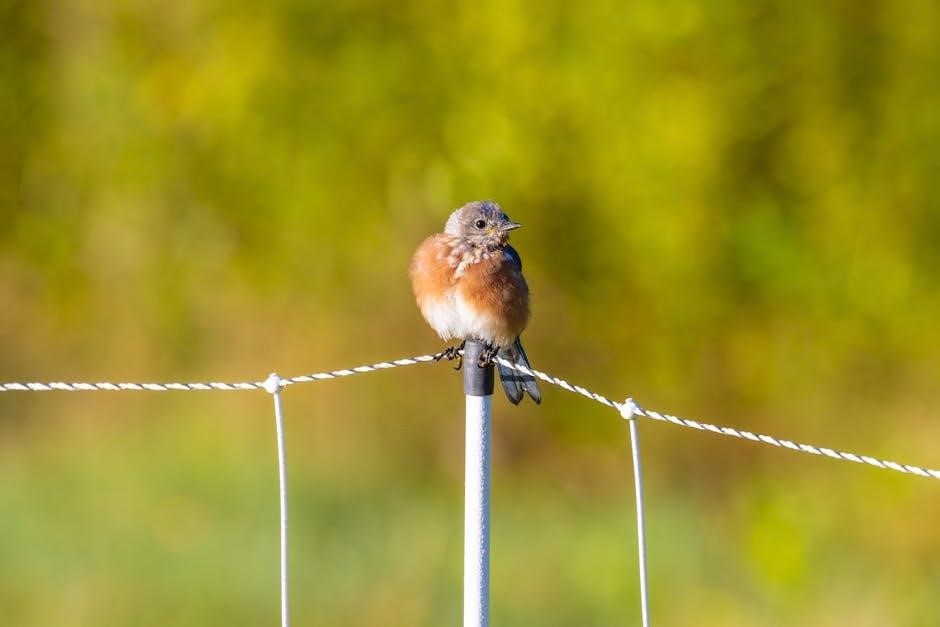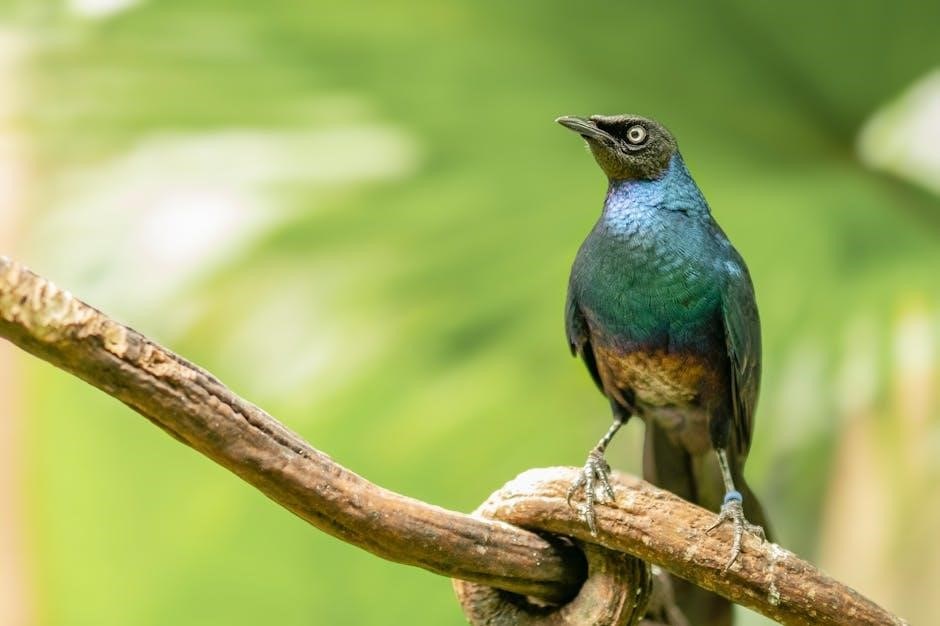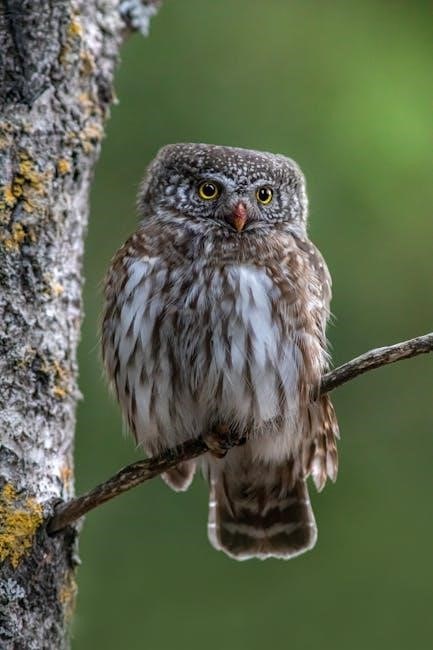John James Audubon, a renowned naturalist and painter, created The Birds of America, a landmark work featuring detailed illustrations of North American bird species. Volume 3 of this series, available as a PDF, showcases his artistic mastery and scientific precision, preserving his legacy for modern audiences.
Background of John James Audubon
John James Audubon, born in 1785 in Les Cayes, Saint-Domingue (now Haiti), was a French-American naturalist, painter, and ornithologist. Raised in France, he developed a passion for nature and art, which led him to study drawing and taxidermy. Audubon immigrated to the United States in 1803, where he pursued business ventures while documenting American bird species. His groundbreaking work, The Birds of America, showcasing 435 hand-colored plates, revolutionized ornithological illustration. Audubon’s innovative techniques, such as using wire armatures to pose birds naturally, set a new standard for scientific art. Despite financial struggles, his dedication to preserving America’s avifauna earned him international acclaim, leaving a lasting legacy in both art and science.

Historical Context of The Birds of America
The Birds of America, created by John James Audubon between 1827 and 1838, is a seminal work in the history of ornithology and natural history art. It emerged during a period of heightened interest in American wildlife and exploration, capturing the diversity of North American bird species. Audubon’s innovative approach to illustrating birds in their natural habitats, often life-sized and in dynamic poses, set a new standard for scientific documentation. The publication faced challenges, including skepticism from European naturalists and financial struggles, but ultimately gained acclaim for its artistic and scientific merits. Volume 3, part of the original four-volume set, continues this legacy, offering detailed insights into America’s avifauna during the 19th century.
Significance of The Birds of America in Ornithological History
The Birds of America is a landmark work in ornithological history, blending art and science to document North American bird species. John James Audubon’s meticulous illustrations, often life-sized and in dynamic poses, set a new standard for zoological art. The work not only advanced the field of ornithology but also raised public awareness of America’s avifauna. Its detailed plates and accompanying text provided invaluable insights into bird behavior, habitats, and species diversity. The publication’s innovative approach influenced future scientific documentation, making it a cornerstone of natural history studies. Volume 3, as part of this series, continues to inspire researchers and enthusiasts, ensuring Audubon’s legacy endures in modern ornithological research and conservation efforts.

Content and Structure of The Birds of America, Volume 3
The Birds of America, Volume 3, part of Audubon’s four-volume set, features plates 201-300, showcasing diverse bird species with intricate details and vibrant illustrations, now available as a PDF.
Bird Species Featured in Volume 3
The Birds of America, Volume 3, contains 100 plates featuring a wide variety of bird species, including waterfowl, songbirds, and raptors. Audubon’s meticulous illustrations capture the unique characteristics of each bird, such as plumage, size, and behavior. The volume includes species like the American Golden-Plover, Snow Goose, and Northern Harrier, showcasing the diversity of North American avifauna. Each plate is accompanied by detailed descriptions, providing insights into the birds’ habitats and behaviors. This volume is a testament to Audubon’s dedication to documenting the natural world, making it an invaluable resource for ornithologists and nature enthusiasts alike. The PDF version preserves the original artwork’s clarity, ensuring its scientific and artistic value endures.
Plate Details and Illustrations in Volume 3
The Birds of America, Volume 3, features 100 exquisite plates, each measuring 39.5 x 26.5 inches, showcasing life-sized bird illustrations. These hand-colored engravings depict species in their natural habitats, highlighting intricate plumage and behavioral traits. The plates are renowned for their vibrant colors and anatomical accuracy, reflecting Audubon’s dedication to both art and science. Digital versions, including PDFs, preserve the original detail, allowing modern audiences to appreciate the intricate craftsmanship. The illustrations in Volume 3 are not only aesthetically stunning but also provide valuable insights into the behaviors and habitats of the birds, making them a cornerstone of ornithological study and appreciation.
Scientific and Artistic Value of the Volume

The Birds of America, Volume 3, holds immense scientific and artistic significance. Its detailed illustrations provide precise depictions of bird anatomy, habitats, and behaviors, serving as a foundational resource for ornithological study. Audubon’s mastery of color and composition elevates the work to a pinnacle of artistic achievement. The volume’s scientific accuracy, combined with its aesthetic appeal, makes it a timeless reference for researchers and enthusiasts alike. Digital versions, such as PDFs, ensure its accessibility, preserving Audubon’s legacy for future generations. This blend of science and art underscores the volume’s enduring value as a cornerstone of natural history documentation.
Publication and Editions of The Birds of America
The Birds of America was originally published between 1827 and 1838 in a double elephant folio set, featuring 435 hand-colored plates. Rare and highly valued, only 120 complete sets exist, making it a treasured collector’s item. Modern editions, including digital PDF versions of Volume 3, allow wider accessibility to Audubon’s groundbreaking work.
Original Publication Details
The original publication of The Birds of America occurred between 1827 and 1838, with John James Audubon overseeing its production in Edinburgh and London. The work was issued in 87 fascicles, or parts, each containing five hand-colored plates. The entire series comprised 435 plates, printed in a double elephant folio format to accommodate life-sized bird illustrations. This monumental project required immense financial and artistic investment, with Audubon traveling extensively to fund and complete the work. The first edition is highly sought after by collectors and institutions, with only 120 complete sets known to exist. Its historical significance lies in its unparalleled detail and artistic quality, making it a cornerstone of ornithological and natural history literature.
Modern Reprints and Digital Versions
Modern reprints of The Birds of America, Volume 3 are widely available, offering accessible versions of Audubon’s iconic work. Digital versions, including PDF formats, provide high-resolution scans of the original plates, preserving the intricate details of Audubon’s illustrations. Platforms like iLovePDF and Adobe Acrobat enable easy viewing and editing of these files, while online marketplaces offer downloadable guides with over 340 pages and 33 full-color images. Additionally, institutions and publishers have released facsimile editions, ensuring the artwork remains vivid and true to the original. These modern adaptations make Audubon’s masterwork accessible to a global audience, blending historical significance with contemporary technology for educational and artistic appreciation.

Availability of PDF Versions Online
PDF versions of The Birds of America, Volume 3 are readily available online, offering convenient access to Audubon’s timeless work. Platforms like iLovePDF and Adobe Acrobat provide high-quality scans, enabling users to download and view the illustrations in detail. The Internet Archive and similar repositories offer free PDF downloads of the volume, complete with Audubon’s original text and plates. Additionally, online marketplaces and digital libraries provide downloadable formats, including JPEG and PDF, making it easy for researchers and enthusiasts to access the content. These digital versions ensure that Audubon’s groundbreaking work remains accessible and preserved for future generations, fostering education and appreciation of ornithological art.

PDF Tools and Resources for The Birds of America
Dedicated PDF tools like Adobe Acrobat, iLovePDF, and WPS Office enable users to view, edit, and convert The Birds of America, Volume 3 seamlessly. Online platforms such as the Internet Archive provide easy access to downloadable PDF versions, ensuring Audubon’s work remains accessible for study and appreciation;
Best PDF Readers for Viewing The Birds of America
Adobe Acrobat Reader and PDF Reader by Kdan Mobile are top choices for viewing The Birds of America, Volume 3 in PDF format. These tools offer features like zoom, bookmarks, and annotation, enhancing the viewing experience. Foxit PDF Reader and MuPDF are also excellent options, providing smooth navigation and high-quality rendering of Audubon’s detailed illustrations. Additionally, these readers support cross-platform compatibility, allowing users to access the document on both desktop and mobile devices. Their ability to handle large files ensures that the high-resolution images in The Birds of America are displayed crisply, preserving the artistic and scientific integrity of Audubon’s work.
PDF Editing and Conversion Tools
For editing and converting The Birds of America, Volume 3 PDF, tools like iLovePDF and WPS Office are highly recommended. These platforms offer features such as merging, splitting, and compressing PDF files, ensuring efficient management of Audubon’s detailed illustrations. Users can also convert PDFs to formats like JPG or Word for further customization. Adobe Acrobat and online converters provide advanced editing options, such as adding annotations or watermarks, while preserving the document’s artistic integrity. These tools are essential for researchers and enthusiasts seeking to adapt or enhance Audubon’s work for modern use, ensuring his legacy remains accessible and engaging for future generations.
Online Platforms for Downloading The Birds of America PDF
Several online platforms offer The Birds of America, Volume 3 in PDF format, providing easy access to Audubon’s iconic work. Websites like the Internet Archive and Google Books host digitized versions of the book, allowing users to download or view it for free; Additionally, platforms such as iLovePDF and Adobe Acrobat offer tools to download and manage PDF files efficiently. The National Audubon Society’s website also provides resources and links to access the volume, ensuring its availability for educational and research purposes. These platforms make Audubon’s groundbreaking illustrations and detailed descriptions accessible to a global audience, preserving his legacy for future generations.

Related Bird Guides and Resources
Handbook of the Birds of the World, Volume 3, and All About Birds of America Guide complement Audubon’s work, offering detailed insights into bird species and their habitats.

Handbook of the Birds of the World, Volume 3
Handbook of the Birds of the World, Volume 3, edited by Josep del Hoyo, Andrew Elliott, and Jordi Sargatal, is a comprehensive guide covering bird species from Sandgrouse to Auks; Published in 1996, this volume is part of a 17-volume set that provides detailed information on bird taxonomy, habitats, and behaviors. Each species is illustrated with high-quality plates and accompanied by maps showing their global distribution. The handbook is renowned for its scientific accuracy and accessibility, making it a valuable resource for ornithologists and bird enthusiasts. It complements John James Audubon’s The Birds of America by offering a modern, global perspective on bird diversity, while Audubon’s work focuses on North American species.
All About Birds of America Guide
All About Birds of America Guide is a comprehensive resource for bird enthusiasts, offering detailed insights into the diverse avifauna of North America. This guide features 340 pages with 33 full-color illustrations, providing vivid depictions of various bird species. It serves as an excellent companion for identifying and understanding bird behavior, habitats, and migration patterns; Available as a digital download, it is accessible to a wide audience, making it a valuable tool for both amateur birdwatchers and seasoned ornithologists. The guide’s user-friendly format and rich content make it an essential reference for anyone exploring the fascinating world of birds in America.
Other Illustrated Bird Guides and Their Significance
Beyond Audubon’s work, other illustrated bird guides have played a crucial role in ornithological research and education. The Handbook of the Birds of the World, for instance, is a multi-volume series that covers bird species globally, offering detailed descriptions and illustrations. Regional guides, such as those focused on specific habitats or geographic regions, provide localized insights, aiding conservation efforts. These resources complement The Birds of America by offering broader or more specialized perspectives. Their significance lies in their ability to educate audiences, inspire appreciation for avifauna, and support scientific research. Together, they form a rich tapestry of knowledge that furthers the understanding and protection of bird species worldwide.
Conservation and Education Efforts by the Audubon Society
The National Audubon Society protects birds and their habitats through science, advocacy, and education, fostering conservation and community involvement to ensure a sustainable future for avifauna.
Mission and Work of the National Audubon Society
The National Audubon Society is dedicated to protecting birds and their habitats across the Americas through science, advocacy, education, and on-the-ground conservation efforts. Founded on the legacy of John James Audubon, the society works to address threats such as climate change, habitat loss, and environmental degradation. By engaging local communities, the Audubon Society promotes bird-friendly practices and advocates for policies that safeguard ecosystems. Its initiatives include restoring wetlands, creating bird sanctuaries, and educating the public about the importance of avian conservation. With a strong network of chapters and partners, the society strives to ensure a sustainable future for bird populations and the natural world they inhabit.
Educational Programs and Resources
The National Audubon Society offers a wide range of educational programs and resources to promote bird conservation and environmental stewardship. These initiatives include educational materials for schools, community workshops, and interactive tools to engage audiences of all ages. The society also provides citizen science projects, enabling individuals to contribute to bird research and conservation efforts. Additionally, digital resources such as PDF guides, including The Birds of America, Volume 3, are available online, offering detailed insights into bird species and habitats. These programs aim to foster a deeper understanding of avian life and inspire action to protect birds and their ecosystems. By leveraging education, the Audubon Society empowers communities to become active participants in conservation.
Conservation Impact and Community Involvement

The National Audubon Society has made significant strides in bird conservation through science-based advocacy and community-driven initiatives. By engaging local communities, the society fosters awareness and participation in protecting bird habitats. Programs such as bird counts and restoration projects involve volunteers, ensuring collective action for conservation. The availability of resources like The Birds of America, Volume 3 in PDF format has further empowered individuals to learn about and advocate for bird species. These efforts have led to measurable positive impacts on bird populations and ecosystems, demonstrating the power of collaborative conservation. The society’s work continues to inspire a broader movement toward environmental stewardship and sustainability.
John James Audubon’s legacy endures through The Birds of America, Volume 3, inspiring future ornithological research. Digital resources like PDFs enhance accessibility, fostering conservation and educational efforts globally.
Legacy of John James Audubon
John James Audubon’s work, particularly The Birds of America, Volume 3, remains a cornerstone of ornithological history. His meticulous illustrations and detailed descriptions revolutionized bird documentation, blending art and science seamlessly. Audubon’s legacy extends beyond his time, as his work continues to inspire researchers, artists, and conservationists. The availability of The Birds of America, Volume 3 in PDF format ensures his contributions are accessible to a global audience, preserving his impact for future generations. Audubon’s dedication to documenting North American bird species has left an indelible mark, making him a timeless figure in the study and appreciation of birds.

Modern Advances in Bird Research and Documentation
Modern advancements in bird research and documentation have significantly enhanced our understanding of avian life, building on foundational works like The Birds of America, Volume 3. Digital tools and platforms now provide high-resolution access to Audubon’s illustrations, enabling detailed analysis and global sharing. Contemporary research leverages technologies such as camera traps, satellite tracking, and genetic sequencing to study bird behavior, migration patterns, and ecological roles. These innovations complement traditional fieldwork, offering deeper insights into bird conservation. Additionally, digital versions of historical texts like Audubon’s work facilitate educational outreach and interdisciplinary collaboration, ensuring that modern bird research remains both accessible and cutting-edge.
The Role of Digital Resources in Bird Conservation
Digital resources have revolutionized bird conservation by providing accessible tools for research, education, and advocacy. PDF versions of The Birds of America, Volume 3 and similar guides enable widespread dissemination of ornithological knowledge. Platforms like iLovePDF and Adobe Acrobat offer functionalities to edit, compress, and share these documents, facilitating collaboration among researchers and conservationists. Additionally, digital archives ensure the preservation of historical works, making them available for future generations. These resources also support educational programs, inspiring public engagement in bird conservation. By leveraging digital technology, organizations like the National Audubon Society can amplify their efforts, promoting science-based advocacy and community involvement to protect avian species and their habitats effectively.
